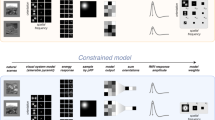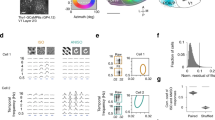Abstract
THE mammalian cortex is organized in a columnar fashion: neurons lying below each other from the pia to the white matter usually share many functional properties. Across the cortical surface, cells with similar response properties are also clustered together, forming elongated bands or patches. Some response properties, such as orientation preference in the visual cortex, change gradually across the cortical surface forming 'orientation maps'. To determine the precise layout of iso-orientation domains, knowledge of responses not only to one but to many stimulus orientations is essential. Therefore, the exact depiction of orientation maps has been hampered by technical difficulties and remained controversial for almost thirty years. Here we use in vivo optical imaging based on intrinsic signals to gather information on the responses of a piece of cortex to gratings in many different orientations. This complete set of responses then provides detailed information on the structure of the orientation map in a large patch of cortex from area 18 of the cat. We find that cortical regions that respond best to one orientation form highly ordered patches rather than elongated bands. These iso-orientation patches are organized around 'orientation centres', producing pinwheel-like patterns in which the orientation preference of cells is changing continuously across the cortex. We have also analysed our data for fast changes in orientation preference and find that these 'fractures' are limited to the orientation centres. The pinwheels and orientation centres are such a prominent organizational feature that it should be important to understand their development as well as their function in the processing of visual information.
This is a preview of subscription content, access via your institution
Access options
Subscribe to this journal
Receive 51 print issues and online access
$199.00 per year
only $3.90 per issue
Buy this article
- Purchase on Springer Link
- Instant access to full article PDF
Prices may be subject to local taxes which are calculated during checkout
Similar content being viewed by others
References
Hubel, D. H. & Wiesel, T. N. J. Physiol., Lond. 160, 106–154 (1963).
Hubel, D. H., Wiesel, T. N. & Stryker, M. P. J. comp. Neurol. 177, 361–380 (1978).
Seelen, W. v. Kybernetik 7, 89–106 (1970).
Braitenberg, V. & Braitenberg, C. Biol. Cybern. 33, 179–186 (1979).
Grinvald, A., Lieke, E., Frostig, R. D., Gilbert, C. D. & Wiesel, T. N. Nature 324, 361–364 (1986).
Löwel, S., Freeman, B. & Singer, W. J. comp. Neurol. 255, 401–415 (1987).
Swindale, N. V., Matsubara, J. A. & Cynader, M. S. J. Neurosci. 7(5), 1414–1427 (1987).
Hubel, D. H. & Wiesel, T. N. J. Physiol., Lond. 160, 106–154 (1962).
Hubel, D. H. & Wiesel, T. N. J. comp. Neurol. 158, 267–293 (1974).
Blasdel, G. G. & Salama, G. Nature 321, 579–585 (1986).
Swindale, N. V. Proc. R. Soc. B215, 211–230 (1982).
Linsker, R. Proc. natn. Acad. Sci. U.S.A. 83, 8779–8783 (1986).
Götz, K. G. Biol. Cybern. 56, 107–109 (1987).
Durbin, R. & Mitchison, G. Nature 343, 644–647 (1990).
Obermayer, K., Ritter, H. & Schulten, K. Proc. natn. Acad. Sci. U.S.A. 90, 8245–8349 (1990).
Frostig, R. D., Lieke, E. E., Ts'o, D. Y. & Grinvald, A. Proc. natn. Acad. Sci. U.S.A. 87, 6082–6086 (1990).
Ts'o, D. Y., Frostig, R. D., Lieke, E. E. & Grinvald, A. Science 249, 417–420 (1990).
Ratzlaff, E. H. & Grinvald, A. J. Neurosci. Meth. 36, 127–137 (1991).
Batschelet, E. Circular Statistics in Biology (Academic, New York, 1981).
Author information
Authors and Affiliations
Rights and permissions
About this article
Cite this article
Bonhoeffer, T., Grinvald, A. Iso-orientation domains in cat visual cortex are arranged in pinwheel-like patterns. Nature 353, 429–431 (1991). https://doi.org/10.1038/353429a0
Received:
Accepted:
Issue Date:
DOI: https://doi.org/10.1038/353429a0
This article is cited by
-
High-dimensional topographic organization of visual features in the primate temporal lobe
Nature Communications (2023)
-
Stimulus edges induce orientation tuning in superior colliculus
Nature Communications (2023)
-
Optical Imaging of the Visual Cortex: Spectral and Amplitude Characteristics of Vasomotor Oscillations
Neuroscience and Behavioral Physiology (2023)
-
Induction of excitatory brain state governs plastic functional changes in visual cortical topology
Brain Structure and Function (2023)
-
Form, synapses and orientation topography of a new cell type in layer 6 of the cat’s primary visual cortex
Scientific Reports (2022)
Comments
By submitting a comment you agree to abide by our Terms and Community Guidelines. If you find something abusive or that does not comply with our terms or guidelines please flag it as inappropriate.



